Tuesday 11/8/2016 - Chindwin River Cruise: Kann Monastery, Kyi Taung Monastery, Kaung Tee Village
We woke up at 6 a.m., took showers, and both dressed in the new longyis that we purchased at the market yesterday. We ate breakfast with Eda, Barbara, Bob, and Bets. We had Monywa noodles which are broad like fettucine. Win the purser prepared it for us, and it was quite spicy and savory. It was delicious. Craig always loves to have spicy local fare at breakfast.
At 8:30, we disembarked at Kann village. The aluminum gangplank led us to a large section of sandy riverbed which is submerged during the monsoon season but exposed now. We walked across the sand, past a man leading his water buffalo down to the river. Two calves went running after them and splashed into the water. Water buffalo are stronger than bulls, but they have less endurance, and need to take frequent breaks.
Unlike some of the villages with steep banks, the village doesn't have much of an elevation gain over the river. We could tell that in the rainy season, the water level reaches the houses. As a result, many of the buildings are elevated. There was a lot of driftwood on the sandbank, and people were using it to construct small shacks and boats.
As we walked up the riverbank, we passed a makeshift bar which was really nothing more than some wooden poles holding up an aluminum roof, with benches and tables inside. A group of men drinking there called out to Craig and wanted to get a photo of him in his longyi. When they saw that I was wearing one too, they had us pose together and took a photo on their cell phones.
Greeting people in their local language is a real ice breaker, and they always react positively when we say "Mingalaba." However, wearing their local dress takes it to another level. Rather than viewing it as appropriation, they truly seem to view it in the way that we intended, as respectful to their culture.
As we get further upriver, people are less used to seeing tourists. They are very friendly and generous with smiles and waves, but some don't wish to be photographed. We always respect their wishes.
We would be visiting two sites on this excursion. One was within walking distance, and we would ride tuk-tuks to the second. We walked down the slightly muddy dirt roads. We passed groups of boys on their way to school in their uniforms: green or teal longyis and white shirts. Most were on foot, but some rode bicycles.
A wooden cart pulled by two Brahma bulls passed us. There were passengers riding in the cart. This age-old transportation contrasted with the motorized tuk-tuks driving behind them. Bets had to jump out of the way when a herd of water buffalo passed by.
When we passed the school, the children who were congregating in the schoolyard and entering their classrooms all smiled, waved, and called to us. They were adorable. Other students already in their classrooms leaned out the windows and craned their necks to see us, smiling and waving.
We passed stupas, some gilded and others painted in cheerful bright colors. One had small statues of what we assume are Nats crouching down, hiding beneath the carved stone like garden gnomes. Skinny cows grazed near the stupas, and water buffalo rested in the grass. Wooden carts were piled with hay.
We walked a short distance along the river to Kann monastery. This monastery was established by the king 155 years ago. We had to be quiet because the main monk was not feeling well and he was resting. The building, elevated by wooden pilings, with its dark teak plank walls and carved detailing, stood in stark contrast to a bright lime green modern building right next door.
We entered the monastery. All of the contruction was made with stained teak wood, and it was quite dark and serene inside. Columns made of teak logs towered up to the rafters. The monks directed our attention to some beautiful wood carvings which decorated the walls.
Craig bowed and said a prayer in front of the colorful altar, which housed several gilded Buddha statues. Behind the altar was a beautifully carved hti (umbrella). All of the hti we had seen thus far had been fashioned from metal. This impressive structure was carved from a single teak log.
We looked at some photos which were on display, depicting the impact of floods on the monastery. The very phenomenon which makes the area so fertile for agriculture can also make it difficult for humans to inhabit the shoreline. Even elevating structures off the ground does not always guarantee their safety when the river floods its banks. This was evidenced in the monastery by some soft rotten wooden floor beams to the left of the altar.
We walked out to the back deck, where there was a small cooking shed. A man used a candle to re-ignite smoldering charcoal on top of an elevated metal platform. A dog was resting under this stove, enjoying the heat. Isn't it hot enough here without literally resting under a fire? We were sweating!
We walked back through the interior and out onto the front deck. When we stepped outside, a 79-year-old man motioned to Craig that he liked his longyi. I took a photo of them together. Craig took a photo of me with a woman who was in her 80's.
Local people were noticing how much Craig was sweating in the heat, and one of the men brought over what looked like a little flag. It was actually a woven fan, and they started fanning Craig with it. Lots of smiles and giggles ensued. Once again, I think that the longyi had broken the ice a bit, and they felt comfortable laughing and joking with us.
Next we took some bright orange tuk-tuks to our next destination. The front end of the vehicle was a motorcycle, and there was a pick-up-truck style bed in the back. The bed had wooden benches along the sides, and there were cushions to soften the ride.
Eda's back has been bothering her, and the prospect of riding down bumpy roads on a hard wooden bench did not sound palatable, cushions or not. Everyone was very accommodating, and they tied a plastic chair to the truck bed, hoping that would provide a more comfortable ride for Eda. She was a good sport and tried it, but it was still too painful. She decided to opt out of the second half of the excursion. The tuk-tuk driver took us back to where the boat was moored, and Eda went back to the boat to rest.
Eda is sharing a cabin with her friend Barbara. Eda (like us) is always hot, but Barbara is always cold, so it is very difficult for them to agree on a mutually comfortable temperature.
We told Eda that we understand how uncomfortable it can be not to be able to cool down in this heat and humidity. We insisted that she rest in our room while we were on the excursion. We keep the room very cool because of Craig's MS. She thanked us and said she would take us up on the offer. We hoped that she would.
We pulled away from the boat and bounced along the rutted, muddy trails (suitable for motorbikes and livestock, but not really cars) to Kyi Taung Oo village. Eda certainly made the right call, as it would undoubtedly wrench her already painful back.
We passed little roadside stalls selling water, snacks, and Fiz Cola. People stood waving at us in front of their traditional wooden homes. In addition to protection from floodwaters, houses raised on wooden pilings also provide shelter for livestock. We noticed cows underneath some of the houses.
We passed over a wooden bridge over a small stream which was flowing into the Chindwin. The rice paddies were so green and lush; the area was absolutely beautiful.
When we got out of our tuk-tuks in Kyi Taung Oo village, we were greeted by an adorable little girl. We visited a bakery housed in the ground floor of a traditional teak house. There were stacks of firewood in the front yard, no doubt to feed the ovens. Stacked on the brick floor were sacks of grain and flats of dozens of eggs. Plastic bags of fresh rolls were displayed in a wooden bakery case, and a sheet pan sized rectangle of conjoined bread loaves waited to be cut apart. There were multiple trays overflowing with fresh round rolls which had been baked in little round muffin tins and needed to be pulled apart from one another.
We stepped from the front room where the baked good were sold to the open-air back room, where they were prepared. It smelled of bread and fire. A large brick oven dominated the space, with a fireplace on each end and an oven in between. Fires roared in each of the fireplaces, and we could feel the blaze of heat on top of the already hot and humid weather.
In addition to the brick oven, there was also a steam oven. This was a cylindrical metal can used to boil water over a wood fire. The steam travels through a pipe and into a sheet metal enclosure. This reminds us of how meat is smoked.
It was quite loud in the bakery. This was due to a belt-driven dough mixer. The thing looked scrounged from junkyard parts, but it was beautiful in its utilitarianism. The bakery was a fascinating place, and we got to taste some of the delicious, fresh-baked rolls.
When we emerged from the bakery, the same little girl who had welcomed us to town had returned, this time with a friend in tow. They were so cute and friendly.
Next we walked to the Kyi Taung monastery. While walking up the cement staircase leading to the top of the hill, we encountered a group of five mothers and their children huddled under the shade of a tree to avoid the intense rays of the sun. The children were eating fresh bread which probably came from the same bakery.
Among the children were adorable 11-month-old twins. One of the twins was sitting on the ground. When I took his photo and showed it to him, he got all excited and started babbling to me. Everyone is so friendly and inquisitive.
The children waved and blew kisses as we continued on our way. The monastery was built by a wealthy family around 285 years ago. It was another gorgeous teak monastery, with gilded columns stretching to the high teak ceilings. We walked barefoot on the wooden plank floors. There were many statues and wall murals which were adorned with gold leaf. The teak interior was painted red and gold, and the sunlight imbued the room with a golden glow. Mala beads were hanging on the wall, and we admired a hammered silver chest decorated with countless images of Buddha.
In a small anteroom containing a television, a ceiling fan, and a water cooler, Craig bowed before a shrine to show respect and say another prayer.
The monastery was currently under restoration, and outside we saw old-fashioned hand planers, chisels, carpenter's squares, and T-shandled augers amidst curlicues of wood shavings. Some of the workers were also utlizing motorized planers and drills.
There were many pretty flowers around the property. Some lovely pink flowers had collected water droplets in their yellow centers. The water droplets reflected the various colors in the sunlight and it was quite enchanting.
We walked down the steps and got back into our tuk-tuks. We retraced our path past verdant green rice paddies until we arrived back at the boat at around 11:30.
The crew gave us a cool facecloth and a cold glass of juice, which were much appreciated in the intense mid-day heat. We noticed that Eda had collected our cabin key as we had instructed, and we were glad to know that she had availed herself of the opportunity to enjoy our air conditioning.
Craig and I cooled down in the cabin for a while before heading to the upper deck for lunch. We sat with Bets, enjoying the following:
- Mohingger soup (fish and chick pea soup with noodles, hard boiled eggs, chili, garlic, and coriander)
- fish satay
- roast duck with sweet soya sauce
- veggie fried rice
- cheeses, salami, pepperoni
- coconut mousse with mango
The food on this boat is truly amazing, and the presentation was world class!
As we were heading upriver, we felt a thump. The river is difficult to navigate, because there are so many sand bars and submerged obstacles such as logs. We didn't know if the propellor hit something or if we had bottomed out on a sand bar. Either way, it wasn't serious enough to put us in danger. It's all part of the adventure.
We rested in the room until we pulled over at the "Captain's choice" village (Kaung Tee Village). As we approached, it seemed like most of the village gathered on the riverbanks to greet us. One woman had an infant who was wearing a bonnet. The baby gave me a big toothless grin as I took a photo - so sweet!
Kids followed us as we walked through the small muddy alleyways. The houses were elevated with various animals underneath. Kids and women had thanaka on their faces. Craig was once again a rock star with people giving him the thumbs up, talking and smiling. I am really proud of how he connects with the people.
We walked along a boardwalk through a marshy area toward the monastery. On the other side of the boardwalk, we reached grassy fields and resplendent green rice paddies. Water buffalo grazed, and men played caneball. The shadows were growing long in the late afternoon sun, giving the place a fairy tale glow. The kids continued to follow us.
Although Sandro had said that we would visit the monastery, he seemed to wordlessly change his mind. We suspect that this was because some members of our group were dressed inappropriately. You are not allowed into pagodas with exposed shoulders, low cut necklines, or skirts above the knee.
[Despite the heat, Craig and I opted to dress modestly all the time on this trip. As much as I would have loved to be in shorts and tank tops, the locals do not dress that way, especially in the countryside. We feel that since we are guests in their communities, we want to follow the local customs in terms of modesty so as not to cause offense.]
Instead of entering the monastery, we went into a school building. A young teacher was giving after school geography help to middle school students. She lives in a neighboring community and stays in this village on weekdays. She has 26 students. Our group circulated through the classroom, greeting the students. They had naturally separated into groups along gender lines, with the boys gathering at the back of the classroom.
We walked back toward the river. We passed livestock including chickens and pigs. One young boy (maybe age 3 or 4) who had been wordlessly and seriously following and watching us, was collected by his dad because it was time for him to go home. He started to struggle and cry, not wanting to leave. Most people in this village enjoyed having their photos taken, and kids were quite curious and friendly.
Before saying farewell to the village, we were invited into the house of the village chief. This position is elected and runs for a term of 5 years. Although he gets a stipend, it is not a full-time job. He still farms to support his family. Other village leaders (heads of households) were there as well.
We all filed in and were directed to sit at a table on benches and plastic chairs. By the time Craig entered, the seats were all filled. One of the village men who had accompanied us on our walk gestured for Craig to join him, sitting crossed-legged on the floor at a low table. He seemed to be one of the heads of household, and he offered Craig some of the food and hot tea that the men had been enjoying. Craig was quite touched, but he politely declined the offer and stuck with his water, trying not to dehydrate.
We had a question and answer session with the chief and heads of household. They asked us questions as well, namely what had motivated us to come to Myanmar. We learned that there were 700 residents in the village, belonging to 120 households.
After thanking the chief and his family for their hospitality, we headed back to the boat.
This was the first clear night on the boat, and we could see the stars and the moon. Htet the bartender came over to tell me the happy hour cocktail was a piña colada - yes please! He also brought us a bowl of freshly made potato chips.
Insects had not been a problem thus far on the boat, but they were out in force tonight. We decided to apply some insect repellant in an attempt to minimize the risk of mosquito-borne illness.
Win and Sandro gave us the rundown of tomorrow's program.
The captain drove in the dark for a while, using a spotlight for illumination. We approached a town where chanting was emanating from an illuminated temple. The ladies of the village were chanting in Pali and Burmese, sending prayers for loving kindness in honor of the 7th day of the waning / waxing moon.
Two people on the shore with flashlights guided the boat to its mooring spot and the crew threw out ropes.
Today was Tuesday, the day of the Presidential election in the United States. However, Myanmar is 11.5 hours ahead of Eastern Standard Time, so it would be tomorrow for us by the time the winner was announced. We were all fairly confident that we could predict the outcome of the election. Craig and I had voted absentee prior to the trip. However, there was some talk of the general surprise of Brexit, and the fact that you never could rule anything out.
We enjoyed our dinner:
- tomato & mozzarella
- roasted garlic soup
- Burmese stye prawn curry (Craig)
- moussaka with lamb (Steph)
- vanilla mousse
After dinner, we went to bed after a busy and quite satisfying day.
Kyi Taung
Kaung Tee Village
|
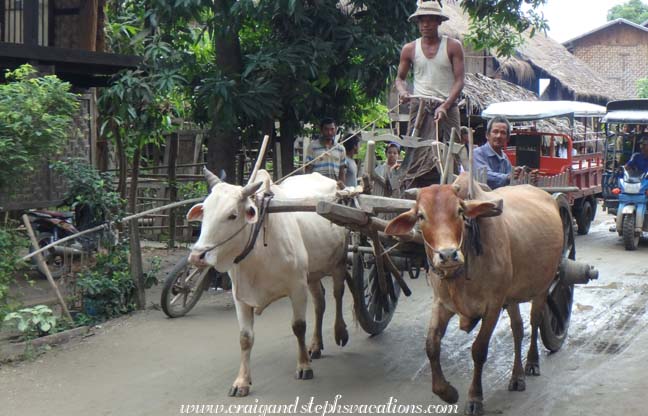
Bullock cart, Kann Village

Cows and pagodas, Kann Village
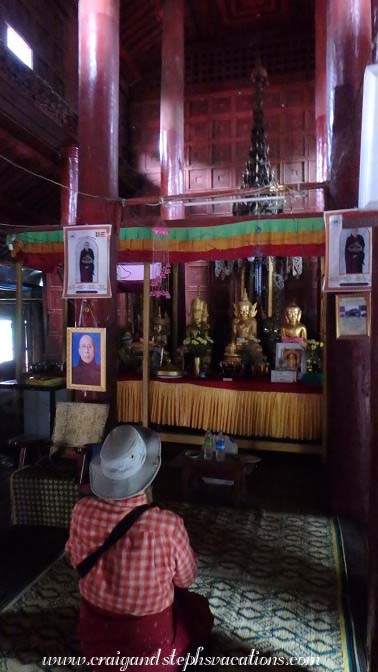
Kann Monastery

Bakery stove, Kyi Taung Village
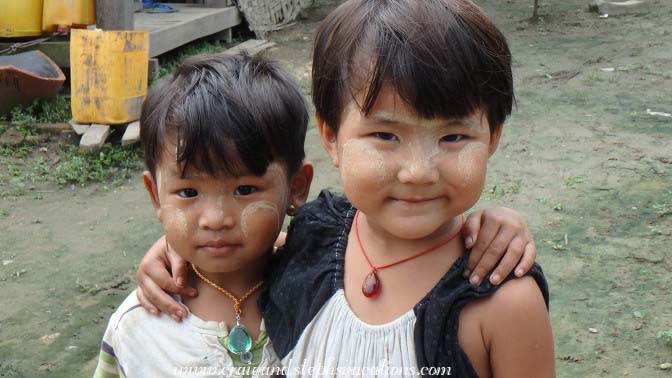
Little girls, Kyi Taung Village

Kyi Taung Monastery
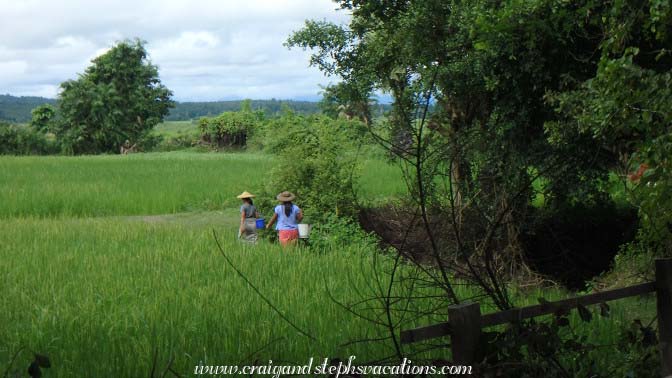
Kyi Taung Village rice paddies
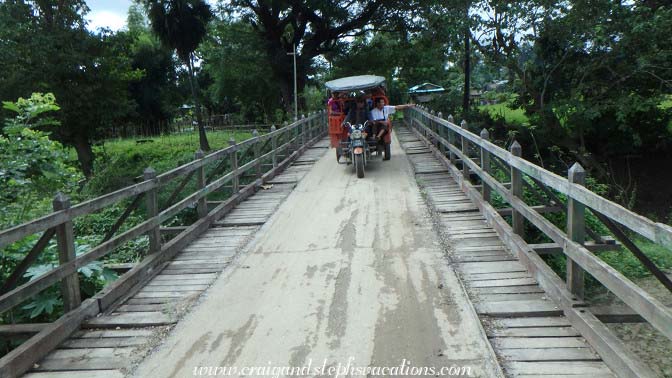
Tuk-tuk ride over a wooden bridge, Kyi Taung Village
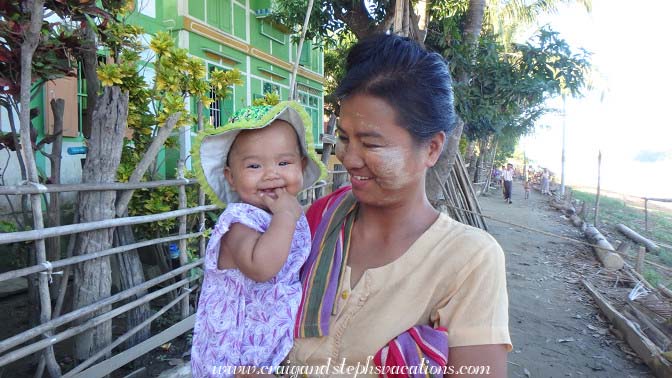
Adorable baby and her mom, Kaung Tee Village

Craig makes new friends at Kaung Tee Village
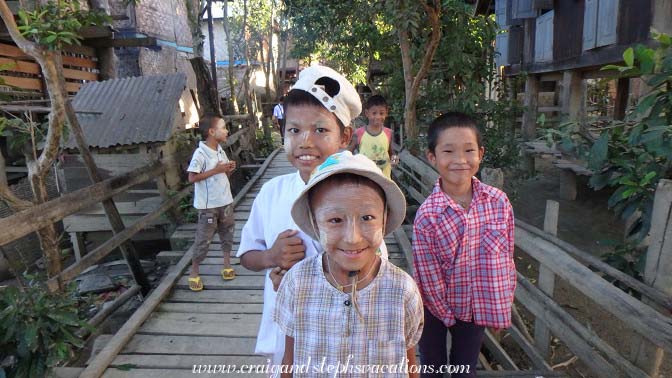
Friendly kids, Kaung Tee Village

Friendly kids, Kaung Tee Village

Middle school geography study group, Kaung Tee Village
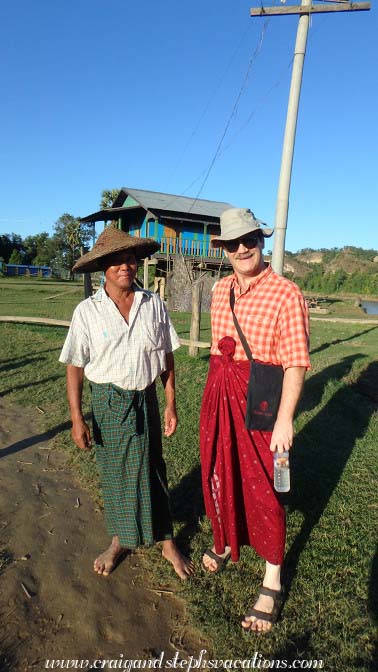
Craig and a new friend, Kaung Tee Village

Village chief, his family, and heads of households, Kaung Tee Village

|






